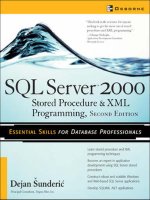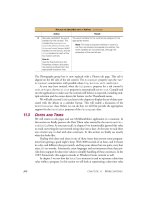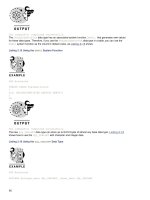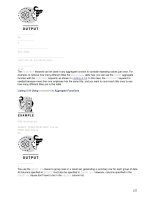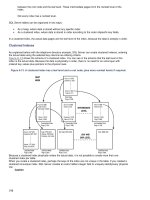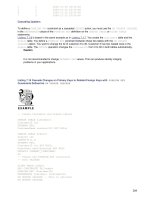SQL Server 2000 Stored Procedure Programming phần 9 potx
Bạn đang xem bản rút gọn của tài liệu. Xem và tải ngay bản đầy đủ của tài liệu tại đây (742.91 KB, 76 trang )
590
SQL Server 2000 Stored Procedure Programming
Model varchar(25) ' /@Model',
comment ntext '@mp:xmltext')
EXEC sp_xml_removedocument @intDoc
return @intErrorCode
Figure 12-10 demonstrates the use of the stored procedure. A long
XML document was created by copying and pasting the same set of
nodes into the string (XML document) over and over.
Publishing Database Information Using XML
SQL Server 2000 has an external set of components that allow users
to access database information in the form of an XML document
Figure 12-10. Use of a text input parameter
Chapter 12: XML Support in SQL Server 2000
591
through the HTTP protocol. It is important to understand that these
components are external. The most important of these is the ISAPI
filter that works within IIS (Internet Information Server—a Web
server), rather than within SQL Server (see Figure 12-11). It retrieves
database information through a SQL Server 2000 OLE DB provider
(SQLOLEDB). The OLE DB provider itself has been modified to use
a new SQLXML.dll component and to support retuning of the result
in the form of a stream. Figure 12-11 illustrates the transfer of
information from a client computer to the server and back.
Configuring Database Access Through HTTP
One new component delivered with SQL Server 2000 is an MMC
snap-in called IIS Virtual Directory Management for SQL Server. This
snap-in provides a graphical user interface for configuring database
access through HTTP. Behind the scenes, it operates using the IIS
Virtual Directory Management for SQL Server Object Model.
Figure 12-11. Accessing database information using XML
592
SQL Server 2000 Stored Procedure Programming
This tool can operate on any edition of Windows NT or Windows
2000. Computers with Windows NT must also have IIS 4.0 or higher
(or Peer Web Services 4.0 or higher on Windows NT Workstation)
and MMC 1.2 or higher.
The configuration of database access requires only one operation—
the administrator needs to create a virtual directory. Apart from the usual
information (such as name and path), this virtual directory must contain
information for accessing the database (login, password, database,
server name, database name, and the type of access allowed through
the URL and virtual names). Before we explain what a virtual name is,
let’s first say that there are three types of access that end users can
accomplish through IIS:
▼
dbobject Users can issue a Select statement as a part of an
HTTP request and access a database object (such as a table or
a view).
■
template Users can specify a template that is a valid XML
document and contains one or more Transact-SQL statements.
SQL Server will execute, and the information will be included
in the result.
▲ schema The URL can be specified to execute an XPath query
against the annotated mapping schema file.
A virtual name is a part of a URL that specifies and executes a
dbobject, a template, or a schema.
Let’s now demonstrate how you can configure IIS to provide
access to SQL Server:
1. Launch IIS Virtual Directory Management for SQL Server:
Start | Programs | Microsoft SQL Server | Configure SQL
XML Support in IIS.
2. When the application appears on the screen, expand the server
to display the Default Web Site. Select it and then select Action |
New | Virtual Directory. The application displays the New
Virtual Directory Properties dialog box.
3. Set the name and the physical path of the virtual directory
(see Figure 12-12).
Chapter 12: XML Support in SQL Server 2000
593
4. Select the Security tab and define the authentication method
that the user will use to connect to the database:
Figure 12-12. Configuring a new virtual directory
594
SQL Server 2000 Stored Procedure Programming
5. Select the Data Source tab to define the server and the
database containing the source information:
6. Select the Settings tab to specify the type of access to allow
through the virtual directory. For training purposes, let’s allow
them all (although on a production server you will probably
allow only templates or XPath).
Chapter 12: XML Support in SQL Server 2000
595
7. Select the Virtual Names tab to associate a specific type of
access and optional directory to a virtual name:
8. Click the New button. The application displays the Virtual
Name Configuration dialog box. Type a new name, specify
a type, select an existing path that will store files, and then
click Save:
9. Repeat step 8 to create virtual names for other types, and then
click OK in the New Virtual Directory Properties dialog box.
The application creates a virtual directory (see Figure 12-13).
596
SQL Server 2000 Stored Procedure Programming
Accessing Database Information Using a URL
After the virtual directory is created, an end user can use a browser
such as Internet Explorer 5.0 to query the database using HTTP GET
and POST methods. The simplest syntax for making such queries
would be:
http://
server
/
virtual_directory
/
virtual_name
?sql=
tsql_statement
Unfortunately, characters such as “ “ (space), “?”, “/”, “%”, “#”,
and “&” have special meanings in URL syntax. Therefore, they must
be encoded using their hexadecimal value in the form “%xx”. For
example, the space character can be replaced using “%20” or “+”.
Therefore, to query the Inventory table, a user can issue the following
statement:
Figure 12-13. A new virtual directory
Chapter 12: XML Support in SQL Server 2000
597
http://MyServer/Asset?sql=select%20top%201%20*%20
from%20Inventory%20for%20xml%20auto
The query returns an XML document that contains just one node (see
Figure 12-14).
If you leave the clause top 1 out of the query,
http://MyServer/Asset?sql=select%20*%20
from%20Inventory%20for%20xml%20auto
the parser will not be able to process the result. The Inventory
element in the result string is repeated for each record and there
is, therefore, no unique top element (see Figure 12-15).
Figure 12-14. An XML document as a result of the database query
598
SQL Server 2000 Stored Procedure Programming
There are two solutions to this problem. You can add a root
parameter to the HTTP GET method, and the server will add a root
node to the result:
&root=
root_node
In this case, the previous query would be
http://dejan/asset?sql=select%20*%20
from%20Inventory%20for%20xml%20auto&root=ROOT
The other alternative is to write the Transact-SQL statement so
that it returns a missing root element. In the following example,
two additional Select statements were added:
http://dejan/Asset?sql=SELECT%20'<Root>';
%20SELECT%20*%20FROM%20Inventory%20FOR%20XML%20AUTO;
%20select%20'</Root>'
The results of both methods are identical (see Figure 12-16).
Figure 12-15. The problem with no unique top element
Unfortunately, many things can go wrong when you connect all
these components and try to make them work together. Internet
Explorer and the XML parser are not ideal debugging tools, which
is understandable considering the number of layers created and the
transformations that occurred.
Using a Stored Procedure Through HTTP
SQL Server 2000 and the ISAPI driver do not force you to use only
the Select statement to get information via HTTP. Naturally, you
can also use stored procedures. The following stored procedure
contains a simple Select statement with a For XML clause:
CREATE PROCEDURE prListEquipment_xml
AS
select *
Chapter 12: XML Support in SQL Server 2000
599
Figure 12-16. The result as an XML document with root element
600
SQL Server 2000 Stored Procedure Programming
from Equipment
for xml auto
The stored procedure can be called through HTTP:
http://dejan/asset?sql=execute%20prListEquipment_xml&root=ROOT
In the following example, we demonstrate two things. First, a
list of parameters can be included as a part of the Transact-SQL
statement that executes the stored procedure. Second, the root
element can be created in the stored procedure as well:
CREATE PROCEDURE prGetEquipment_xml
@EquipmentId int
AS
Select '<Root>'
Select * from Equipment
Where EquipmentID= @EquipmentId
For XML AUTO, elements
Select '</Root>'
This stored procedure can be called using the following URL:
http://dejan/asset?sql=execute%20prGetEquipment_xml%20@EquipmentId=5
Naturally, you are not required to use named parameters. The
following URL is also legal, but a little bit confusing to read:
http://dejan/asset?sql=execute%20prGetEquipment_xml%205
Accessing Database Information Using Templates
In the preceding section, we showed how you can incorporate a
Transact-SQL statement as a part of the URL to access information
via HTTP. Naturally, you cannot use this technique on a production
system, because
▼
It is too complicated for end users.
■
It is prone to errors.
Chapter 12: XML Support in SQL Server 2000
601
■
The security of the system could be compromised easily.
■
Browsers support only a limited URL length (2K).
▲
It is unrealistic to expect users to have adequate technical
knowledge and understanding of the details of the technical
implementation of the system.
Fortunately, there is an alternative—templates.
Syntax
A template file is an XML document that contains all the
technical information such as For XML and XPath queries,
parameters, and XSL transformation files required to access and
process database information. Template files have the following
syntax:
<ROOT xmlns:sql="urn:schemas-microsoft-com:xml-sql"
sql:xsl='
XSL_FileName
' >
<sql:header>
<sql:param name=
parameter_name
>
default_value
</sql:param>
<sql:header>
<sql:query>
tsql_statements
</sql:query>
<sql:XPath-query mapping-schema="
Schema_FileName
">
XPath_query
</sql:XPath-query>
</ROOT>
The root element of the template file has one mandatory and one
optional parameter. All other elements and attributes of the template
file are declared in the urn:schemas-microsoft-com:xml-sql
namespace. Therefore, all template files must have an xmlns:sql=
“urn:schemas-microsoft-com:xml-sql” attribute. The xsl
attribute is optional. It is used to specify the name of the XSL
transformation file.
602
SQL Server 2000 Stored Procedure Programming
Using Query
The <sql:query> element is used to specify one or
more Transact-SQL statements. The following template file queries
the Equipment table:
<root xmlns:sql='urn:schemas-microsoft-com:xml-sql'>
<sql:query>
select * from Equipment for XML auto, elements
</sql:query>
</root>
If the template file is saved in ListEqupment.xml in the template
folder, it can be executed using the following URL:
http://dejan/asset/template/ListEquipment.xml
You can see the result in Figure 12-17.
Figure 12-17. The result of an XML template designed for accessing database
information
Chapter 12: XML Support in SQL Server 2000
603
NOTE:
The template file can contain more than one
<sql:query>
(and
<sql:XPath-query>
). It is important to know that all queries
contained within separate elements are treated as separate transactions.
Even if some of these transactions fail, others will be executed
independently.
Using Parameters
If the Transact-SQL statements contain parameters,
they are defined in the <sql:header> element. The parameter’s
definition contains the name of the parameter and the default value
to be assigned to the parameter if a value is not specified:
<sql:param name=
parameter_name
>
default_value
</sql:param>
The following example contains a simple template file with two
parameters:
<root xmlns:sql='urn:schemas-microsoft-com:xml-sql'>
<sql:header>
<sql:param name='Make' >Toshiba</sql:param>
<sql:param name='Model'>Portege 7020CT</sql:param>
</sql:header>
<sql:query>
exec prGetEquipment2_xml @Make, @Model
</sql:query>
</root>
Let’s assume that the template is stored in the GetEquipment.xml
file in the template folder. As usual, the parameter list in the URL
starts with a “?” character. If multiple parameters are listed, they
should be delimited with an “&” character. Parameters such as
strings (that are delimited with quotes in Transact-SQL) must be
delimited without quotes, as shown in the following URL:
http://dejan/asset/template/GetEquipment2.xml?Make=Toshiba&Model
=Portege%207020CT
You can see the result in Figure 12-18.
604
SQL Server 2000 Stored Procedure Programming
Using XSL
It is possible to use XSL files to change the way
information is presented in a Web browser. The following template
references a query (stored procedure) that provides an XML result
and an XSL file that converts it to HTML (Equipment.xsl):
<?xml version ='1.0' encoding='UTF-8'?>
<root xmlns:sql='urn:schemas-microsoft-com:xml-sql'
sql:xsl='/Equipment.xsl'>
<sql:query>
exec prListEquipment2_xml
</sql:query>
</root>
If you execute just the stored procedure (for example, from Query
Analyzer), you can see the simple XML document it produces:
Figure 12-18. The result of an XML template with parameters
Chapter 12: XML Support in SQL Server 2000
605
<Equipment
EquipmentId="1"
Make="Toshiba"
Model="Portege 7020CT">
<EqType EqType="Desktop"/>
</Equipment>
<Equipment
EquipmentId="2"
Make="Sony"
Model="Trinitron 17XE">
<EqType EqType="Monitor"/>
</Equipment>
<Equipment
EquipmentId="6"
Make="NEC"
Model="V90">
<EqType EqType="Desktop"/>
</Equipment>
The XSL file shown in the following code snippet describes how
the XML file is converted:
<?xml version='1.0' encoding='UTF-8'?>
<xsl:stylesheet xmlns:xsl=' >
<xsl:template match = '*'>
<xsl:apply-templates />
</xsl:template>
<xsl:template match = 'Equipment'>
<TR>
<TD><xsl:value-of select = '@EquipmentId' /></TD>
<TD><xsl:value-of select = '@Make' /></TD>
<TD><xsl:value-of select = '@Model' /></TD>
<TD><xsl:value-of select = './EqType/@EqType' /></TD>
</TR>
</xsl:template>
<xsl:template match = '/'>
<HTML>
<HEAD>
<title>Equipment</title>
606
SQL Server 2000 Stored Procedure Programming
</HEAD>
<BODY>
<TABLE border = "1" width="100%">
<TR><TH colspan="4" bgcolor="#000000">
<p align="left"><font color="#FFFFFF" face="Arial">
<b>Equipment</b>
</font>
</p>
</TH></TR>
<TR>
<TH align="left" bgcolor="#C0C0C0">
<b><font face="Arial" size="2">
Equipment ID
</font></b>
</TH>
<TH align="left" bgcolor="#C0C0C0">
<b><font face="Arial" size="2">
Make
</font></b>
</TH>
<TH align="left" bgcolor="#C0C0C0">
<b><font face="Arial" size="2">
Model
</font></b>
</TH>
<TH align="left" bgcolor="#C0C0C0">
<b><font face="Arial" size="2">
Equipment Type
</font></b>
</TH>
</TR>
<xsl:apply-templates select = 'root' />
</TABLE>
</BODY>
</HTML>
</xsl:template>
</xsl:stylesheet>
Chapter 12: XML Support in SQL Server 2000
607
You can distinguish two segments within the XSL file. The last
<xsl:template match = ‘/’> element defines the static part of the
HTML page. It consists of the <HEAD> and <BODY> tags of the HTML
page and the definition of the table (the <TABLE> tag). Because of the
match = ‘/’ attribute, the described transformation is performed on
the root node of the XML document.
The second <xsl:template match = ‘Equipment’> element
is applied on each element node called ‘Equipment’. Each node is
converted to a row within an HTML table (using row <TR> and
column <TD> tags):
<xsl:template match = 'Equipment'>
</TR>
<TD><xsl:value-of select = '@EquipmentId' /></TD>
<TD><xsl:value-of select = '@Make' /></TD>
<TD><xsl:value-of select = '@Model' /></TD>
<TD><xsl:value-of select = 'EqType/@EqType' /></TD>
</TR>
</xsl:template>
The <xsl:value-of> elements define the source from which the
parser obtains the values of the table cells. Recall that in the XPath
section earlier in this chapter, ‘@EquipmentId’ referred to an
attribute called EquipmentId (not a Transact-SQL local variable).
The last node reference (‘EqType/@EqType’) is most interesting. It
first points to a child node named EqType and then to its attribute
named EqType.
To execute the template file, you can specify the following URL:
http://c400/asset/template/ListEquipmentWithXSL.xml
Unfortunately, Internet Explorer displays HTML code as shown in
Figure 12-19.
To see how everything works together, you must prompt Internet
Explorer to treat the content received from the Web server as an
608
SQL Server 2000 Stored Procedure Programming
HTML file rather than an XML file. You must specify an additional
parameter (contenttype=text/html) when you specify the URL:
http://c400/asset/template/ListEquipmentWithXSL.xml?contenttype=text/html
You can see the result in Figure 12-20.
Using XPath
The <sql:XPath-query> element of the template is used
to specify XPath query expressions and mapping schema against which
the XPath query expression is executed. We will not describe mapping
schemas until the next section, so we will demonstrate XPath queries in
this section on the simplest possible schema.
If you execute a simple Select statement with a For XML clause
that contains an XMLData option against the Equipment table,
Select EquipmentId, Make, Model from Equipment For XML auto, XMLData
Figure 12-19. HTML code obtained using an XML template with XSL
Chapter 12: XML Support in SQL Server 2000
609
you get a simple inline XDR schema at the beginning of the XML
document:
<Schema name="Schema" xmlns="urn:schemas-microsoft-com:xml-data"
xmlns:dt="urn:schemas-microsoft-com:datatypes">
<ElementType name="Equipment" content="empty" model="closed">
<AttributeType name="EquipmentId" dt:type="i4"/>
<AttributeType name="Make" dt:type="string"/>
<AttributeType name="Model" dt:type="string"/>
<attribute type="EquipmentId"/>
<attribute type="Make"/>
<attribute type="Model"/>
</ElementType>
</Schema>
<Equipment xmlns="x-schema:#Schema" EquipmentId="1" Make="Toshiba"
Model="Portege 7020CT"/>
Figure 12-20. The XML template with XSL converts result to an HTML page
610
SQL Server 2000 Stored Procedure Programming
To get a proper mapping schema in this case, you need to extract
the schema into a separate file and to add another namespace to it
(xmlns:sql=“urn:schemas-microsoft-com:xml-sql”):
<Schema name="Schema" xmlns="urn:schemas-microsoft-com:xml-data"
xmlns:dt="urn:schemas-microsoft-com:datatypes"
xmlns:sql="urn:schemas-microsoft-com:xml-sql">
<ElementType name="Equipment" content="empty" model="closed">
<AttributeType name="EquipmentId" dt:type="i4"/>
<AttributeType name="Make" dt:type="string"/>
<AttributeType name="Model" dt:type="string"/>
<attribute type="EquipmentId"/>
<attribute type="Make"/>
<attribute type="Model"/>
</ElementType>
</Schema>
NOTE:
This is not the only operation needed to create a mapping schema. It
is successful in this case only because the target XML document is so simple.
We will explore the details of mapping a schema in the following section.
Now it is possible to create a template file to use the XPath query
to get information using this schema:
<ROOT xmlns:sql="urn:schemas-microsoft-com:xml-sql">
<sql:xpath-query mapping-schema="EqSchema.xml">
Equipment
</sql:xpath-query>
</ROOT>
The schema is referenced in a mapping-schema attribute, and
the XPath query is specified as the content of the <sql:xpath>
element. The XPath query in the template references only Equipment
nodes. If the template and the schema are stored in EqTemplate.xml
and EqSchema.xml in the template virtual directory, they can be
executed using:
http://c400/asset/template/EqTemplate.xml
Figure 12-21 shows the result.
We can use more complicated XPath queries in a template:
<ROOT xmlns:sql="urn:schemas-microsoft-com:xml-sql">
<sql:xpath-query mapping-schema="EqSchema.xml">
Equipment[@EquipmentId=1]
</sql:xpath-query>
</ROOT>
This query filters Element nodes that have an EquipmentId attribute
with a value set to 1. Figure 12-22 shows the result.
XML Views Based on Annotations of XDR Schemas
In the preceding section, we demonstrated how XDR schemas and
XPath queries can be used to retrieve data from a database. We will
now examine the use of XDR schemas for mapping in greater detail.
Chapter 12: XML Support in SQL Server 2000
611
Figure 12-21. Using an XPath query in a template file
612
SQL Server 2000 Stored Procedure Programming
The main purpose of an XDR schema is to define the structure of the
XML document. SQL Server 2000 extends the XDR schema language
with annotations designed to map XML nodes (elements and attributes)
and database objects (tables, views, and columns). Other annotations
allow features such as the definition of hierarchical relationships between
XML nodes, change of a target namespace, and the retrieval of
XML-encoded data from a database. Such XDR schemas produce XML
documents that behave in a fashion similar to database views and,
therefore, are sometimes called XML views.
Mapping Tables, Views, and Columns
The schema used in the preceding
section was based on default mapping between tables and elements,
Figure 12-22. Using an XPath query to filter result
and between columns and attributes. Since SQL Server was able to
find a table that corresponded to the specified element and attributes
that corresponded to the table’s columns, the result was an XML
document containing information from the database table.
In the case where an element is named differently than a table (or
a view), you must add a sql:relation annotation (an attribute of
the <ElementType> tag) to the schema. In the case where attributes
of the element are named differently from the columns of the table
(or the view), you must add a sql:field annotation (an attribute
of the <attribute> tag) to the schema. In the following example,
the Equipment table is mapped to the element <Part> and columns
EquipmentId and Make are mapped to attributes PartNum and
Manufacturer:
<Schema name="Schema"
xmlns="urn:schemas-microsoft-com:xml-data"
xmlns:dt="urn:schemas-microsoft-com:datatypes"
xmlns:sql="urn:schemas-microsoft-com:xml-sql">
<ElementType name="Part" sql:relation="Equipment"
content="empty" model="closed">
<AttributeType name="PartNum" dt:type="i4" />
<AttributeType name="Manufacturer" dt:type="string" />
<AttributeType name="Model" dt:type="string"/>
<attribute type="PartNum" sql:field="EquipmentId"/>
<attribute type="Manufacturer" sql:field="Make"/>
<attribute type="Model"/>
</ElementType>
</Schema>
This schema can be used by the following template:
<ROOT xmlns:sql="urn:schemas-microsoft-com:xml-sql">
<sql:xpath-query mapping-schema="PartSchema.xml">
Part
</sql:xpath-query>
</ROOT>
The result is shown in Figure 12-23.
Chapter 12: XML Support in SQL Server 2000
613
sql:field annotations can be applied to elements as well. The
following schema is not attribute-based, but element-based:
<Schema name="Schema"
xmlns="urn:schemas-microsoft-com:xml-data"
xmlns:dt="urn:schemas-microsoft-com:datatypes"
xmlns:sql="urn:schemas-microsoft-com:xml-sql">
<ElementType name="Part" sql:relation="Equipment"
content="eltOnly" model="closed" order="many">
<element type="PartNo" sql:field="EquipmentId"/>
<element type="Manufacturer" sql:field="Make"/>
<element type="Model"/>
</ElementType>
<ElementType name="PartNo" content="textOnly"
model="closed" dt:type="i4"/>
614
SQL Server 2000 Stored Procedure Programming
Figure 12-23. The result of the annotated schema
